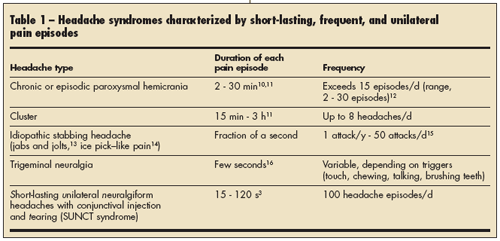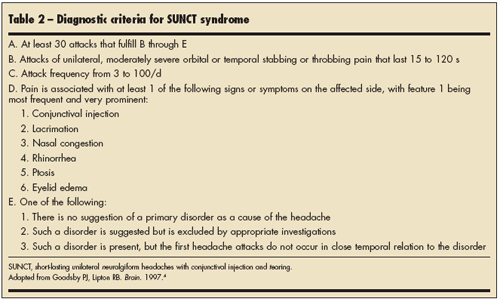Man With Multiple Short-Lasting, Unilateral Daily Headaches
The patient is a 56-year-old man who presents with daily headaches that occurbehind the right eye, right temple, and occasionally on the right side of theforehead. He has never experienced this type of headache on the left side. Hedescribes the pain as “stabbing,” “throbbing,” and occasionally “burning.”He rates the intensity of the pain a 7 on a 10-point visual analog scale onwhich 10 is the most severe.
THE CASE:The patient is a 56-year-old man who presents with daily headaches that occur behind the right eye, right temple, and occasionally on the right side of the forehead. He has never experienced this type of headache on the left side. He describes the pain as “stabbing,” “throbbing,” and occasionally “burning.” He rates the intensity of the pain a 7 on a 10-point visual analog scale on which 10 is the most severe.
The acute headaches last between 20 and 40 seconds; the severe component of each episode lasts for about 3 seconds. The patient reports that on some days he suffers from 12 to 100 acute episodes per day (usually about 40 to 60). Occasionally, his headaches resolve for a few days or a week without special treatment, but they eventually recur.
The patient also reports conjunctival injection and lacrimation of the right eye during each headache attack. He sometimes experiences congestion of the right nostril during an attack but denies any associated nausea or vomiting. He has tried different abortive medications (including triptans, indomethacin, and over-the-counter analgesics) without success.
This patient’s headaches started 2 years ago without any precipitating factors. Since then, they have become more frequent, but the clinical features are unchanged.
MRI and magnetic resonance angiography (MRA) scans of the brain are normal.
THE DIALOGUE:Primary care doctor: On what basis should the diagnosis be made in this case?
Headache specialist: The diagnosis of a primary headache disorder usually cannot be made or verified based on any available diagnostic methods, such as MRI or MRA. Thus, the clinical peculiarities of the headache-as noted in a complete history-should facilitate the diagnosis.
The pattern of this patient’s headaches bears close scrutiny. His headaches have certain clinical features that suggest a group of chronic headache syndromes characterized by attacks that are short-lasting, frequent, and unilateral (Table 1). Initially, attention needs to be directed to the most typical and the most unusual headache signs for this patient-such as the duration of the acute attack, the frequency, and the location.

This patient complains of headaches that last about 20 to 40 seconds and occur 40 to 60 times daily. The headaches always occur on the right side. These features suggest that the patient has one of a specific group of headaches that includes episodic and chronic paroxysmal hemicrania, short-lasting unilateral neuralgiform headaches with conjunctival injection and tearing (SUNCT syndrome), idiopathic stabbing headache, cluster headache, and trigeminal neuralgia.
Primary care doctor: What clinical features distinguish these headache types from each other?
Headache specialist: To establish a differential diagnosis, consider the exact duration of the headache attack and the exact frequency of the headache episodes. Minor clinical details can play a dramatic role in establishing the diagnosis. It is crucial to clarify the duration of the acute headache episode, which differs from one headache type to another (see Table 1).
Primary care doctor: If the clinical features of these headache types are so similar, can they all be treated in the same manner?
Headache specialist: Unfortunately, no; treatment differs for each headache type. Certain medications produce a dramatic effect in some of these headache types but have no effect in others.
In some patients, a dramatic response to medication can be part of the diagnostic process; for example, indomethacin is the treatment of choice for the chronic and episodic hemicranias and is considered the sine qua non for establishing the diagnosis.1 However, we are not certain how best to treat other headache syndromes with similar presentations.
Primary care doctor: What is the diagnosis in this patient?
Headache specialist: He almost certainly suffers from SUNCT syndrome. This diagnosis is based on the unilateral pain, its severity, the significant associated autonomic signs (unilateral conjunctival injection and lacrimation), and the normal MRI and MRA results.
SUNCT syndrome is the rarest type of primary headache disorder. Sjaastad and colleagues2 first described it in 1978. This disorder has male predominance (2.25:1). The mean age of onset is 51 years (range, 23 to 77 years).3
Typically, the headache is unilateral and located around the eye with radiation to the ipsilateral temple or forehead. Patients describe the headache as severe burning, stabbing, or throbbing pain that can occur up to 100 times a day. The acute headache attack is brief (15 to 120 seconds).3 The headache is always associated with conjunctival injection and lacrimation on the ipsilateral side.
Symptomatic periods usually last from a few days to a few months. The headache may then resolve without any special treatment. Remissions may last from a few days to several months or even years.
The clinical criteria for the diagnosis of SUNCT syndrome were suggested by Goadsby and Lipton4 in 1997 (Table 2).

Primary care doctor: What causes SUNCT syndrome?
Headache specialist: The exact cause and pathogenesis are still unknown. Secondary causes of SUNCT syndrome have been reported in 3 patients.5-7Primary care doctor: What are the treatment options?
Headache specialist: Unfortunately, SUNCT syndrome is remarkably refractory to treatment. Unlike some other short-lasting headache syndromes that are highly responsive to indomethacin-such as the episodic and chronic hemicranias and hypnic headache-SUNCT syndrome does not usually respond to this medication. Moreover, other medications used to treat migraine-such as triptans and agents that contain ergotamine-are also usually ineffective in SUNCT syndrome. Some reports show that carbamazepine is helpful.3 Other case reports have demonstrated modest efficacy with sumatriptan, valproate, prednisone, and lamotrigine.8,9 The patient in this case had some success with oxygen therapy.
Primary care doctor: Why do primary care clinicians need to know about SUNCT syndrome?
Headache specialist: Although SUNCT syndrome is rare, it can easily confuse the physician and thus lead to misdiagnosis of another type of headache disorder, such as cluster headache, chronic or paroxysmal hemicrania, trigeminal neuralgia, or idiopathic stabbing headache. Considering the severity of the pain syndrome in all these conditions, the high frequency of headache attacks, and the potential for patients to be disabled, it is crucial to differentiate among these pain disorders and implement the appropriate treatment. Patients with SUNCT syndrome are best referred to a headache specialist.
References:
REFERENCES:
1.
Antonaci F, Pareja JA, Caminero AB, Sjaastad O. Chronic paroxysmal hemicraniaand hemicrania continua. Parenteral indomethacin: the “indotest.”
Headache.
1998;38:122-128.
2.
Sjaastad O, Russell D, Horven I, et al. Multiple neuralgiform unilateralheadache attacks associated with conjunctival injection and appearing in clusters.A nosological problem.
Proc Scand Migraine Soc.
1978;31.
3.
Pareja JA, Sjaastad O. SUNCT syndrome. A clinical review.
Headache.
1997;37:195-202.
4.
Goadsby PJ, Lipton RB. A review of paroxysmal hemicranias, SUNCT syndromeand other short-lasting headaches with autonomic feature, including newcases.
Brain.
1997;120:193-209.
5.
Bussone G, Leone M, Dalla Volta G, et al. Short-lasting unilateral neuralgiformheadache attacks with tearing and conjunctival injection: the first symptomaticcase?
Cephalalgia.
1991;11:123-127.
6.
De Benedittis G. SUNCT syndrome associated with cavernous angioma ofthe brain stem.
Cephalalgia.
1996;16:503-506.
7.
Morales F, Mostacero E, Marta J, Sanchez S. Vascular malformation of thecerebellopontine angle associated with “SUNCT” syndrome.
Cephalalgia.
1994;14:301-302.
8.
Pareja JA, Kruszewski P, Sjaastad O. SUNCT syndrome: trials of drugs andanesthetic blockades.
Headache.
1995;35:138-142.
9.
Ghose RR. SUNCT syndrome.
Med J Aust.
1995;162:667-668.
10.
Antonaci F, Sjaastad O. Chronic paroxysmal hemicrania (CPH): a review ofthe clinical manifestations.
Headache.
1989;29:648-656.
11.
Headache Classification Committee of the International Headache Society.Classification and diagnostic criteria for headache disorders, cranial neuralgiasand facial pain.
Cephalalgia.
1998;8(suppl 7):1-96.
12.
Sjaastad O, Apfelbaum R, Caskey W, et al. Chronic paroxysmal hemicrania(CPH). The clinical manifestations. A review.
Ups J Med Sci Suppl.
1980;31:27-33.
13.
Sjaastad O.
Cluster Headache Syndrome.
Philadelphia: WB Saunders Company;1992.
14.
Raskin NH, Schwartz RK. Icepick-like pain.
Neurology.
1980;30:203-205.
15.
Pareja JA, Ruiz J, de Isla C, et al. Idiopathic stabbing headache (jabs andjolts syndrome).
Cephalalgia.
1996;16:93-96.
16.
Sjaastad O, Pareja JA, Zukerman E, et al. Trigeminal neuralgia. Clinicalmanifestations of first division involvement.
Headache.
1997;37:346-357.